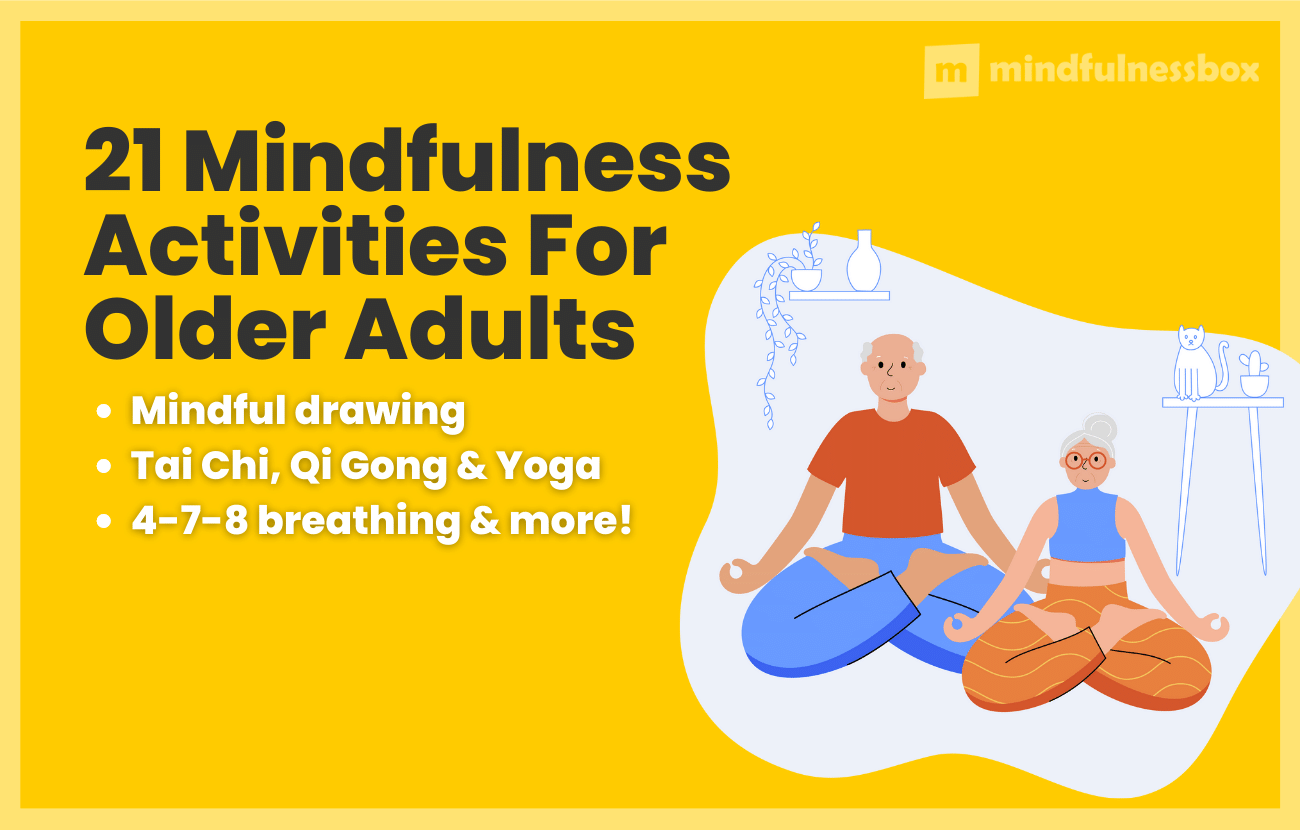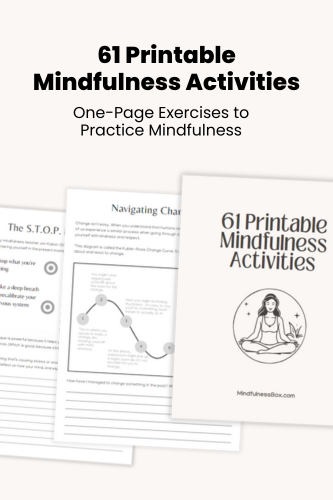Some mindfulness activities that may appeal to seniors and older adults include mindful breathing exercises, gentle yoga or tai chi, nature walks, meditation, mindful art, journaling, and mindful listening to music or poetry.
Mindfulness skills such as self-compassion, patience, awareness, emotional balance, and calming the nervous system can be especially beneficial for older adults.
By selecting mindfulness activities that are tailored to their interests and abilities, older adults can benefit from the physical, emotional, and cognitive benefits of mindfulness practices.
Get dozens of one-page exercises to help practice mindfulness, meditation, gratitude, and self love. Perfect for printable handouts when teaching mindfulness to groups, students, or in the workplace.
To see examples, plus a full list of the 61 exercises included, click below.
1. Mindful drawing and art
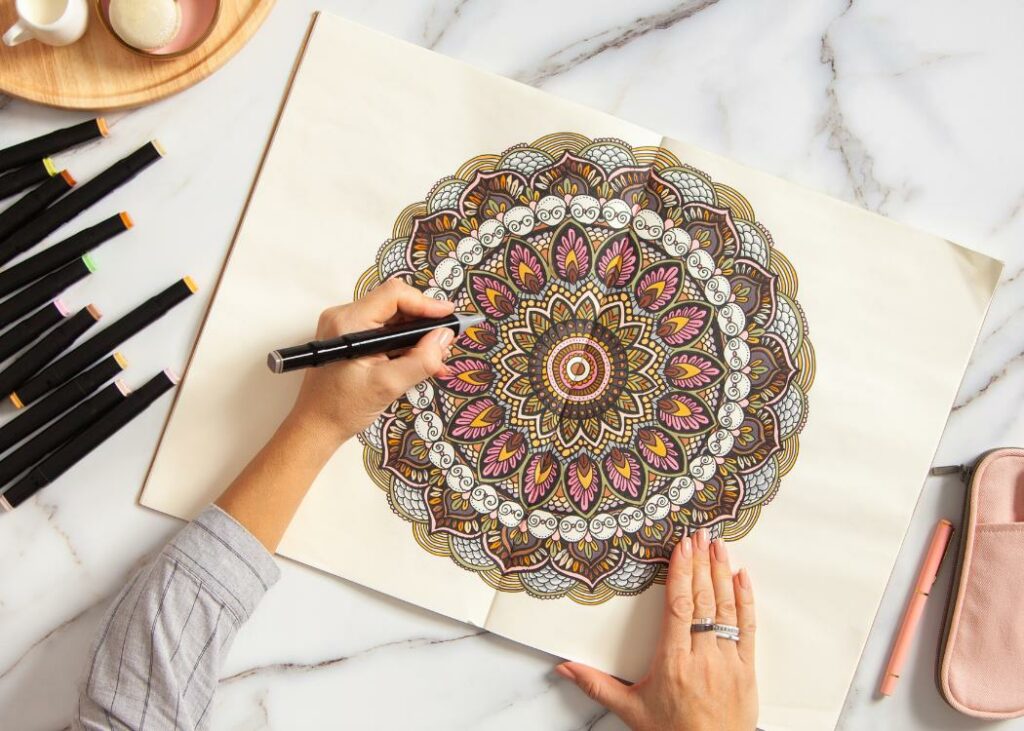
Mindful coloring or drawing is one of the best calming mindful art activities for adults. If you’re putting together activities to promote mindfulness for seniors, this is one of the best ways to focus on the present moment and reduce stress and anxiety.
A mandala is a circular design made up of intricate patterns and shapes, often used in spiritual or meditative practices.
Here’s how you can do mindful coloring with a mandala:
- Choose a mandala that you would like to color. You can find free mandala coloring pages online or in coloring books.
- Set aside a quiet, comfortable space where you can focus on the coloring. Make sure you have all the necessary coloring tools, such as colored pencils, markers or crayons.
- Take a few deep breaths to calm your mind and focus on the present moment. Try to clear your mind of any distracting thoughts and focus on the mandala in front of you.
- Begin coloring the mandala. Start from the center and work your way outward, following the patterns and shapes of the mandala. You can use any colors you like, but try to choose colors that you find calming and relaxing.
- Focus on the coloring process and try to stay present in the moment. Pay attention to the patterns and shapes as you color, and notice how the colors blend and interact with each other.
- If your mind starts to wander or you feel distracted, take a deep breath and refocus on the mandala in front of you.
- Continue coloring the mandala until you have finished the entire design. Once you have completed the coloring, take a few moments to reflect on how you feel. Notice any changes in your mood or stress levels, and take note of any thoughts or emotions that may have come up during the process.
By focusing on the present moment and the intricacies of the mandala, you can achieve a state of mindfulness and feel more grounded and centered.
2. Cook mindfully

By practicing mindfulness while cooking, you can bring more awareness and joy to the experience. Mindful cooking can also help you develop a deeper connection to the food you eat and the people you share it with.
Here’s how to practice mindful cooking:
- Set the intention: Before you begin cooking, set the intention to be present in the moment and focus on the experience of cooking.
- Choose your ingredients mindfully: Take the time to select your ingredients carefully, paying attention to their colors, textures, and smells.
- Focus on the task at hand: When you begin cooking, focus on the present moment and the task at hand. Take note of the sounds, smells, and sensations involved in the cooking process.
- Use all your senses: Engage all of your senses while you cook. Listen to the sizzle of the pan, smell the aroma of the spices, and feel the texture of the ingredients.
- Avoid distractions: Try to minimize distractions while you cook. Turn off your phone and avoid other tasks that may divert your attention.
- Embrace imperfection: Cooking can be a messy and imperfect process. Embrace imperfections and focus on the experience of cooking, rather than achieving perfection.
- Practice gratitude: Take a moment to appreciate the food you’re cooking, the people who will be sharing it, and the processes that brought it to your plate.
3. Take mindful showers
Practicing a mindful shower involves several steps, including setting the intention to be present, focusing on the sensations of the water, using all senses to engage in the moment, taking deep breaths, and practicing gratitude.
It’s easy to practice mindful shower meditation:
By staying present in the moment, one can focus on the physical sensations of the water, the scents of soaps and shampoos, and the sounds of the shower. If the mind begins to wander, bring it back to the present moment by focusing on the sensations of the water.
Taking a few moments for self-care can help to reduce stress, increase relaxation, and improve overall well-being. By practicing mindfulness during a shower, one can transform it into a meditative and rejuvenating experience.
4. Read mindfully
One of the most natural activities to promote mindfulness for older adults is mindful reading.
By practicing mindfulness while reading, you can develop a deeper connection with the text and enhance your overall reading experience.
Mindful reading can also help to reduce stress, improve focus, and promote relaxation.
Here are some instructions for reading mindfully:
- Set the intention: Before you begin reading, set the intention to be present and fully engaged in the reading experience.
- Choose a quiet space: Find a quiet space where you won’t be distracted by noise or interruptions.
- Pay attention to your posture: Sit comfortably with your back straight, and keep your eyes at a comfortable distance from the text.
- Take a few deep breaths: Take a few deep breaths to relax your mind and body.
- Read slowly: Read the text slowly, taking time to absorb each word and sentence. Avoid rushing through the text or skim reading.
- Engage with the text: As you read, engage with the text by asking questions, making connections, and visualizing the scenes and characters.
- Take breaks: Take breaks as needed, to give yourself time to reflect on what you’ve read.
- Practice gratitude: Take a moment to appreciate the opportunity to read and learn, and the experience of engaging with the text.
5. Wash your hands mindfully

Washing your hands might just be the perfect mindfulness activity:
- It’s something you do many times a day
- It often happens in the privacy of a bathroom
- There are sounds and sensations to focus on
- Bathrooms often have a mirror; seeing your reflection can serve as a trigger to remind you to be mindful for 30-60 seconds while you wash your hands
To wash your hands mindfully, follow the usual steps, but at a slower pace. Observe each phase of the process, and take note of the sensation of the soapy lather on your skin and the water’s temperature.
6. Take a moment for mindful eating
I often fall into the trap of eating my meals quickly, sometimes without even noticing what I’m doing. Notice if your eating experience is similar. Is eating becoming an automatic process for you?
Mindfulness is about paying attention to the present moment, whatever it is you’re doing.
When it comes to eating, try and gently stop yourself if you notice you’re eating on autopilot. Then, shift your attention. Try slowing down, and paying attention to the texture and flavor of the food and drink. Take a piece of food and savor it. Noticing how it tastes and smells. Notice how the meal feels as you slow down and pay attention.
Here are 5 steps for practicing mindful eating:
- Slow down: Take the time to appreciate your food. Eat slowly and savor each bite. Chew thoroughly and put down your utensils between bites.
- Engage your senses: Pay attention to the flavors, textures, smells, and colors of your food. Take in the details of your food and appreciate the sensory experience.
- Focus on your food: Try to avoid distractions while eating. Turn off the TV, put down your phone, and sit at a table to eat. This helps you stay present and focus on the experience of eating.
- Tune into your body: Check in with your hunger and fullness levels. Pause occasionally during the meal to assess how full you feel. This can help you avoid overeating.
- Practice gratitude: Take a moment to appreciate your food and the people and processes that brought it to your plate. This can help you develop a deeper appreciation for your food and enhance the overall eating experience.
7. Practice movement meditation
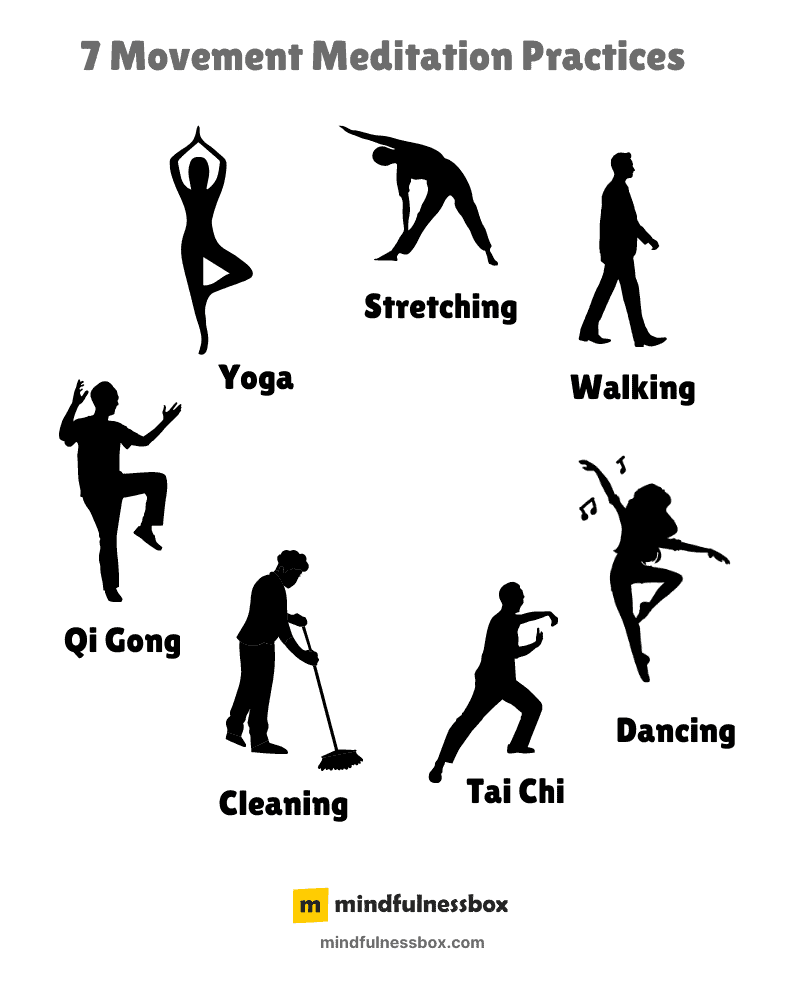
Did you know you don’t have to sit still on a cushion in order to meditate?
Movement meditation is a practice that combines the physical movement of the body with the focus and awareness of the mind.
Here are some examples of movement meditation:
- Qi Gong: Qi Gong is a Chinese practice that involves a series of slow and graceful movements, deep breathing, and mental concentration. It aims to balance the flow of energy in the body, promote relaxation, and improve overall health.
- Tai Chi: Tai Chi is another Chinese practice that involves a series of flowing movements and deep breathing. It is often described as “meditation in motion” and is known for its gentle and calming effects.
- Yoga: Yoga is a physical, mental, and spiritual practice that originated in India. It involves various postures, movements, and breathing exercises that aim to promote relaxation, flexibility, strength, and inner peace.
- Mindful Walking: Mindful walking is a simple but effective form of movement meditation. It involves walking slowly and intentionally, paying attention to the sensations in the body and the surrounding environment. It can be done in a natural setting, such as a park or forest, or in an urban area, such as a busy street.
8. Try 4-7-8 breathing
The 4-7-8 method is one of the best breathing exercises for seniors.
A simple breathing technique to center yourself and calm your nervous system, the 4-7-8 breathing technique helps to provide a mindful moment through the experience of intentional breathing.
To start, first get comfortable. Sit or lie down, then breathe through your nose for 4 seconds. Hold your breath for 7 seconds. Then, breath forcefully out for 8 seconds.
Try doing multiple cycles of 4-7-8 breathing over the course of a few minutes.
9. Listen to music mindfully
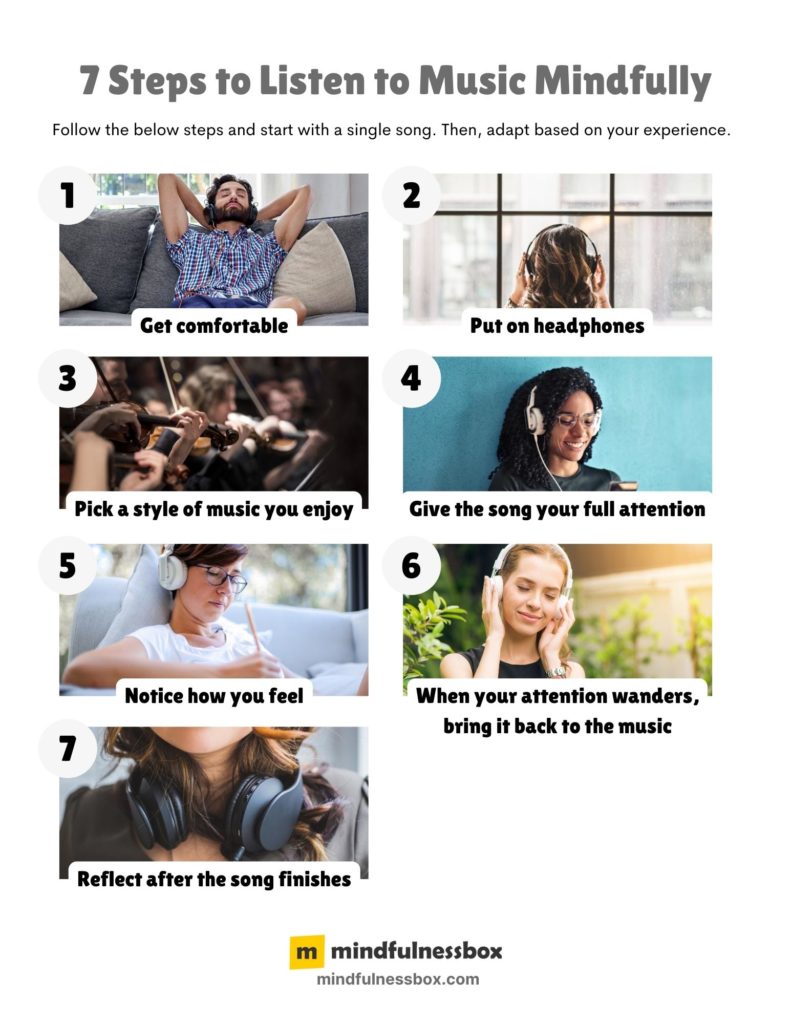
What does it mean to mindfully listen to music? By bringing your full awareness to whatever you’re listening to. When your attention drifts, bring it back to the present moment and the experience of listening to each layer of sound.
Wearing headphones and listening to a song that’s entirely new to you are a couple of ways to facilitate listening to music mindfully.
10. Practice box breathing
Box breathing is part breathing technique, part visualization exercise. It’s simply another approach towards holding your attention onto an object of concentration, as a way to practice staying in the present moment while calming your nervous system.
Here’s how to practice box breathing:
- Find a comfortable seated position and take a few deep breaths to relax.
- Inhale through your nose slowly and deeply for a count of four.
- Hold your breath for a count of four.
- Exhale through your mouth slowly and fully for a count of four.
- Hold your breath for a count of four.
- Repeat steps 2 to 5 for several cycles or until you feel calm and relaxed.
It’s important to focus on your breath and keep a steady pace throughout the exercise. You can practice box breathing anytime and anywhere, such as before a presentation, during a stressful moment, or as part of a daily mindfulness practice.
11. Notice what’s within your circle of control
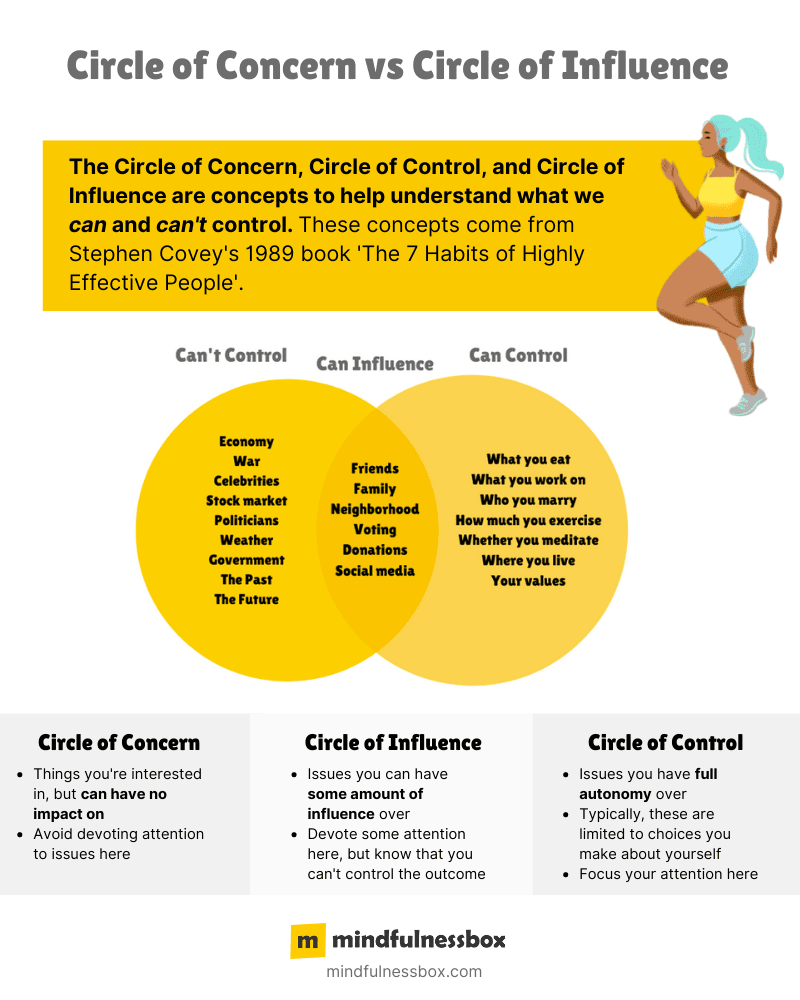
There’s so much in life that we have no control over: the stock market, the weather, politics, government, how other people choose to behave.
These things you have no way to control or affect fall within your Circle of Concern. Ask yourself how much of your mental energy is being spent here.
At the same time, there’s plenty in your life that you can control: where you live, your job, your attitude, your philosophy, what you read, who you marry, how much you exercise.
This is your Circle of Control. How would it feel if you focused more of your energy in this area?
12. Try the STOP method
Ever need a quick mindful break? The STOP method is a simple grounding exercise that helps you reconnect with yourself.
Here’s how to practice the STOP method:
- Stop: Pause what you’re doing or thinking. Just stop and be present in the moment.
- Take a breath: Take a deep breath and focus on the physical sensation of the breath moving in and out of your body. This helps to ground you in the present moment.
- Observe: Observe your thoughts, emotions, and physical sensations. Notice what’s going on without judgment or reaction. Just observe and be curious.
- Proceed: Decide what you need to do next. Proceed with your day with greater mindfulness and awareness, making choices that align with your values and goals.
The STOP method can be used anytime and anywhere, whether you’re feeling stressed, anxious, overwhelmed, or just need a moment to regroup. It can help you pause, shift your focus, and respond with greater intention and clarity. With regular practice, the STOP method can become a valuable tool for managing stress and enhancing your overall well-being.
13. When things are boring, be curious
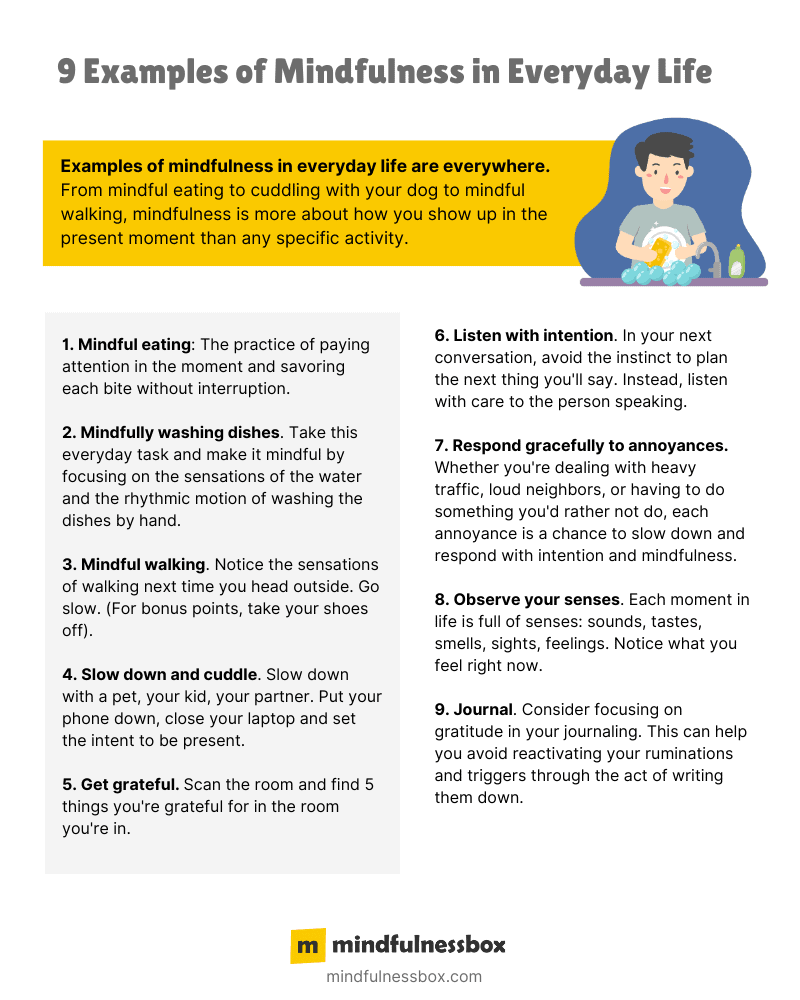
In your daily life, you probably encounter many moments that may seem mundane and uninteresting:
- Waiting at a traffic light
- Standing in an elevator
- Sitting in a doctor’s office
However, these moments can also be transformed into opportunities for mindfulness, and personal growth.
When you find yourself waiting for water to boil or in a grocery store checkout line, you can choose to be present and mindful. Rather than becoming frustrated or letting your mind wander, you can observe your surroundings with curiosity and openness. Pay attention to the sounds, smells, and sensations of your environment, without judgment or distraction.
When standing in an elevator, you can focus on your breath and the physical sensations of your body, while also noticing the movement of the elevator. In the doctor’s office, you can take a moment to check in with your body and observe any physical sensations or emotions that may be present.
With mindfulness, you can appreciate even the most ordinary moments and bring more presence, calm, and joy into your daily life.
14. Yawn and stretch
Who doesn’t appreciate an opportunity to yawn and stretch?
Especially if you’re designing a mindfulness activity that takes place in the morning, there’s no better icebreaker than to give everyone a chance to do what they really want to do:
Acknowledge that they’re tired!
But yawning and stretching slowly is also a mindfulness exercise in its own right. It can bring you back to your body, and help you notice and release areas of tension.
15. Try the raisin mindfulness meditation
Mindfulness meditation for seniors doesn’t have to always involve sitting on a cushion.
The raisin exercise is a practice that teaches you to linger on food, noticing the texture, taste, and smell on a deeper level than you normally would.
It doesn’t have to be done with a raisin, either. Pick your favorite food, or even a cup of tea, and approach it with intention, slowly.
16. Practice alternate nostril breathing
Here’s an easy one. When you’re looking for a quick mindfulness activity, alternate nostril breathing provides a great structure to help you manage your breath, while regulating the nervous system and promoting relaxation.
To get started, just place your thumb on your right nostril. Then, breathe slowly through the left nostril. Switch to the other nostril, and repeat the process 3-4 more times.
17. Go barefoot
A great way to shake yourself out of your normal routine, and into a new way of looking at the world, is to go barefoot.
First of all, going barefoot is just plain fun. When everyone takes their shoes off and starts moving around, it brings a new kind of energy into the room.
But more importantly, intentionally observing the world while barefoot can be a great mindfulness activity, especially for those who have trouble with meditation. Walking barefoot is a way to focus on sensations you normally wouldn’t notice.
To get started, have participants take their socks and shoes off and walk around on the carpet or floor. What feelings do they notice? Is there any other surface they can step on? How does it compare? Have them wiggle their toes, move their feet, and really feel the surface of the ground as they slowly pay attention to the experience of walking in a deeper way than before.
This activity pairs well with walking meditation, too.
18. Start a mindfulness journal
Journaling is an excellent tool for introspection, but it’s also the perfect mindfulness activity because it allows you to clear your mind and turn jumbled thoughts into something concrete.
You can also use journaling as a mindfulness tool with mindfulness journal prompts that invite you to reflect on different aspects of mindfulness in your life.
Here’s a mindfulness journal template that’ll help you get started fast.
19. Make a list of things to be grateful for
Life is short, and one of the great risks of life is that we move through it without appreciating the moment that we’re in.
The good news is, there are so many reasons to be grateful that once you make a habit of looking for them, they start showing up everywhere.
(If you’re looking for inspiration, here are 101 reasons to be grateful.)
20. Identify your emotions
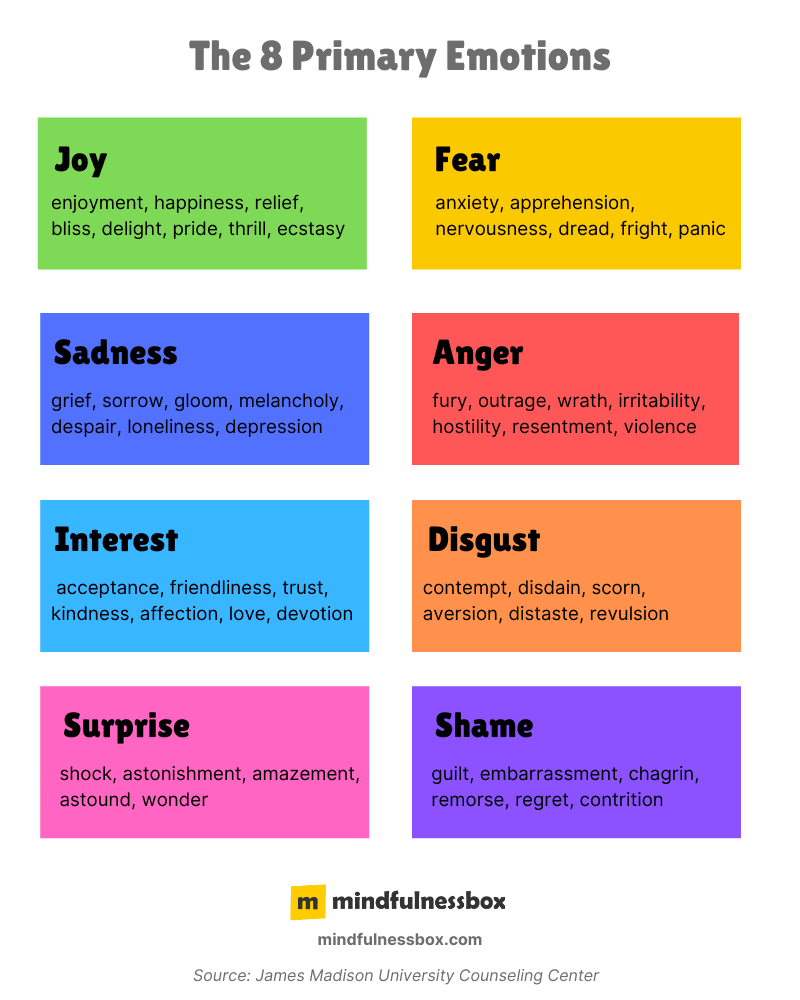
Mindfulness is all about walking through life with awareness, rather than stumbling around on autopilot. That’s why emotional activities for seniors are such an important part of mindfulness curriculum.
But being aware of how you feel, and identifying the specific emotions that are coming up for you, are two distinct skills.
Consider learning about the eight primary emotions – like anger, fear, joy, and sadness – so you can practice identifying them as they come up, rather than letting your feelings go unknown.
Learn more about how to identify your emotions.
21. Be self-compassionate
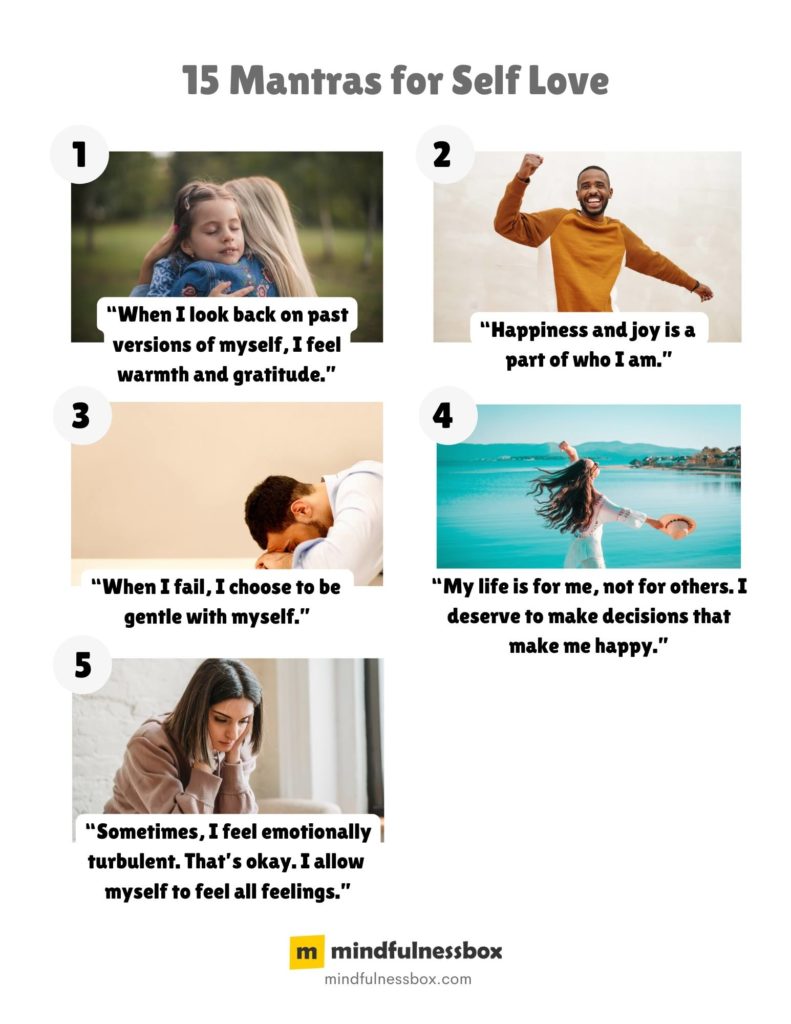
Self-compassion is an essential skill for operating in the world, because so many of us are too hard on ourselves.
Instead, we need to treat ourselves as we would a dear friend or a child: with patience, understanding, forgiveness, and compassion.
If you catch yourself falling into a pattern of negative self-talk, challenge yourself to try a different approach. Ask yourself, “How would I treat a friend who was talking to herself or himself this way?”
Check out this list of self love mantras.

My mindfulness practice kicked off in 2016 with a ten-day silent retreat. Since then, I’ve read dozens of books about mindfulness and completed hundreds of hours of meditation. Thinking about what makes humans happy, calm, and peaceful is endlessly fascinating to me.

